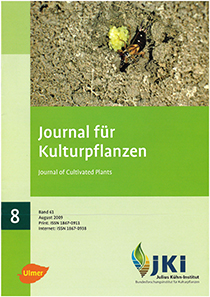Investigations on the population ecology and the population control of the Common earwig <em>Forficula auricularia</em> (Linnaeus) in vineyards of the Palatinate
DOI:
https://doi.org/10.5073/JfK.2009.08.01Keywords:
Forficula auricularia, Common earwig, pest, bamboo tube, life cycle, population ecology, population control, SpinTorAbstract
The Common earwig has been classified as a beneficial predator in vineyards. Amongst others the insect feeds on grape pests like different tortricids. In recent years within many regions of the viticultural area of the Palatinate the individual densities increased to an extremely high level. Earwigs may cause direct damages such as contamination of the grapes with faeces, eroded berries and transfer of pathogens. The chemical agent 2-methyl-1,4-benzoquinone, released from the abdominal glands while earwigs are menaced and likewise contained in faeces, may have a negative influence on the wine quality. All these facts constitute a quality downslide by winegrowers. The high number of earwigs in the grapes after harvesting causes a negative image by consumers.
This study was carried out to investigate possible relations between the population dynamics of earwigs and specific environmental conditions in vineyards. The main focus of the research project is to test chemical, ecological and biological strategies to reduce the population densities. Another important point of survey was to study the life cycle of earwigs especially in vineyards.
For sampling purposes in the trunk zone a special life trap out of bamboo tubes has been developed. This type of trap showed the highest catch rate of the four trapping types tested. For the monitoring of ground dwelling earwigs pitfall traps were used.
Downloads
Published
Issue
Section
License
The content of the journal is licensed under the Creative Commons Attribution 4.0 License. Any user is free to share and adapt (remix, transform, build upon) the content as long as the original publication is attributed (authors, title, year, journal, issue, pages).
The copyright of the published work remains with the authors. The authors grant the Journal of Cultivated Plants, the Julius Kühn-Institut and the OpenAgrar repository the non-exclusive right to distribute and exploit the work.







